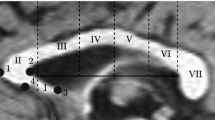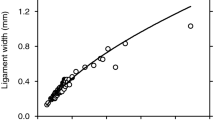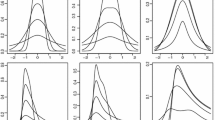Abstract
Examining sigmoidal allometries in geometrical space can be carried away by direct nonlinear regression or generalized additive modeling approaches. Nevertheless, producing consistent estimates of breakpoints characterizing phases composing sigmoidal heterogeneity could be problematic. Here, we explain how the paradigm of weighted multiple–phase allometries embraced by the mixture structure of the total output of a first-order Takagi–Sugeno–Kang fuzzy model can carry on this task in a direct, intuitive and efficient way. Present calibration tasks relied on log-transformed amniote testes mass allometry data. The considered TSK fuzzy model approach not only offers a way to back the assumption that analyzed testes mass allometry is sigmoidal in geometrical space but beyond this, it provided meaningful estimates for transition among involved phases. Results confirm previously raised views on the superior capabilities of the addressed fuzzy approach to validating prior subjective knowledge in allometry.
Access this chapter
Tax calculation will be finalised at checkout
Purchases are for personal use only
Similar content being viewed by others
References
Akaike, H. 1974. A new look at the statistical model identification. IEEE Transactions on Automatic Control, 19(6).
Azeem, M.F., M. Hanmandlu, and N. Ahmad. 2000. Generalization of adaptive neuro-fuzzy inference systems. IEEE Transactions Neural Networks 11 (6): 1332–1346.
Beckman, R.J., and R.D. Cook. 1979. Testing for two-phase regressions. Technometrics 21: 65–69.
Bervian, G., N. Fontoura, and M. Haimovici. 2006. Statistical model of variable allometric growth: Otolith growth in Micropogonias furnieri (Actinopterygii, Sciaenidae). Journal of Fish Biology 68: 196–208.
Bezdek, J.C., and S.K. Pal. 1992. Fuzzy models for pattern recognition. New York: IEEE Press.
Bull, W.B. 1975. Allometric Change of Landforms. Geological Society of America Bulletin 86: 1489.
Castro, J.R., O. Castillo, M.A. Sanchez, O. Mendoza, A. Rodríguez-Díaz, and P. Melin. 2016. Method for higher order polynomial sugeno fuzzy inference systems. Information Science 351: 76–89.
Champernowne, D.G. 1953. A model of income distribution. Economic Journal 63 (250): 318–351.
Chiu, S.L. 1994. Fuzzy model identification based on cluster estimation. Journal of Intelligent & Fuzzy Systems 2 (3): 267–278.
Coccia, M. 2018. New directions in measurement of economic growth, development and under development. Journal of Economics and Political Economy - JEPE 4 (4): 382–395.
Cohn, D., S. Ghahramani, and M. Jordan. 1997. Active learning with mixture models. In Multiple Model Approaches to Modeling and Control, ed. R. Murray-Smith, and T. Johansen. London: Taylor and Francis.
De Robertis, A., and K. Williams. 2008. Weight-length relationships in fisheries studies. The standard allometric model should be applied with caution. Transactions of the American Fisheries Society, 137(3): 707–719.
Dechnik-Vázquez, Y.A., L. García-Barrios, N. Ramirez-Marcial, M. van Noordwijk, and A. Alayon-Gamboa. 2019. Assessment of browsed plants in a sub-tropical forest frontier by means of fuzzy inference. Journal of Environmental Management 236: 163–181.
Dreyer, O. 2001. Allometric scaling and central source systems. Physical Review Letters, 87(3)
Echavarria-Heeras, H., C. Leal-Ramirez, E. Villa-Diharce, and A. Montesinos-Lopez. 2019a. Examination of the effects of curvature in geometrical space on accuracy of scaling derived projectinos of plant biomass units: Applicationsto the assessment of average leaf biomass in Elgrass Shoots. BioMed Research International, 3613679: 1–23.
Echavarría-Heras, H., C. Leal-Ramírez, J.R. Castro-Rodríguez, E. Villa-Diharce, and O. Castillo. 2018. A takagi-sugeno-kang fuzzy model formalization of eelgrass leaf biomass allometry with application to the estimation of average biomass of leaves in shoots: Comparing the reproducibility strength of the present fuzzy and related crisp proxies. In Fuzzy logic augmentation of neural and optimization algorithms, ed. O. Castillo, P. Melin, and J. Kacprzyk, 329–362. Switzerland: Springer.
Echavarria-Heras, H., C. Leal-Ramirez, E. Villa-Diharce, and N. Cazarez-Castro. 2018. On the suitability of an allometric proxy for nondestructive estimation of average leaf dry weight in eelgrass shoots I: Sensitivity analysis and examination of the influences of data quality, analysis method, and sample size on precision. Theoretical Biology and Medical Modelling 15: 4.
Echavarria-Heras, H., C. Leal-Ramirez, E. Villa-Diharce, and J.R. Castro-Rodríguez. 2019. A generalized model of complex allometry I: Formal setup, identification procedures and applications to non-destructive estimation of plant biomass units. Applied Science 9: 1–42.
Echavarria-Heras, H.A., J.R. Castro-Rodriguez, C. Leal-Ramirez, and E. Villa-Diharce. 2020. Assessment of a Takagi–Sugeno-Kang fuzzy model assembly for examination of polyphasic loglinear allometry. PeerJ 8: e8173.
El Naschie, M.S. 2004. A review of E-infinity theory and the mass spectrum of high energy particle physics. Chaos, Solitons & Fractals 19: 209–236.
Eleveld, D.J., J.H. Proost, H. Vereecke, A.R. Absalom, E. Olofsen, J. Vuyk, and M.M.R.F. Struys. 2017. An allometric model of remifentanil pharmacokinetics and pharmacodynamics. Anesthesiology 126 (6): 1005–1018.
Emlen, D. 1996. Artificial selection on horn length-body size allometry in the horned beetle onthophagus acuminatus (Coleoptera: Scarabaeidae). Evolution 50 (3): 1219–1230.
Ertel, J.E., and E.B. Fowlkes. 1976. Some algorithms for linear spline and piecewise multiple linear regression. Journal of the American Statistical Association 71: 640–648.
Forbes, T.L., and G.R. López. 1989. Determination of critical periods in ontogenetic trajectories. Functional Ecology 3: 625–632.
Frankino, W.A., D.J. Emlen, and A.W. Shingleton. 2010. Experimental approaches to studying the evolution of animal form: The shape of things to come. In Experimental evolution: Concepts, methods, and applications of selection experiments, ed. T. Garland and M.R. Rose, 419–478. Berkeley: University of California Press.
Gan, M.T., M. Hanmandlu, and A.H. Tan. 2005. From Gaussian mixture model to additive fuzzy systems. IEEE Transactions on Fuzzy Systems 13 (3): 303–316.
Glazier, D., M. Powell, and T. Deptola. 2013. Body-size scaling of metabolic rate in the trilobite Eldredgeops rana. Paleobiology 39 (1): 109–122.
Gould, S.J. 1966. Allometry and size in ontogeny and phylogeny. Biological Reviews 41: 587–640.
Huxley, J.S. 1932. Problems of relative growth. London: Methuen.
Jang, J.S., C.T. Sun, and E. Mizutani. 1997. Neuro-Fuzzy and soft computing: A computational approach to learning and machine intel.
Ji-Huan, H., and L. Jun-Fang. 2009. Allometric scaling laws in biology and physics. Chaos Solitons & Fractals, 41(4).
Kalbfleisch, J.G. 1985. Probability and statistical inference, volume 2: Statistical inference, 2nd ed. Berlin: Spinger.
Kolokotrones, T., V. Savage, E.J. Deeds, and W. Fontana. 2010. Curvature in metabolic scaling. Nature 464: 753–756.
Kwak, H.S., H.G. Im, and E.B. Shim. 2016. A model for allometric scaling of mammalian metabolism with ambient heat loss. Integrative Medicine Research 5 (1): 30–36.
Larsen, P.M. 1980. Industrial applications of fuzzy logic control. International Journal of Man-Machine Studies 12: 3–10.
Lemaître, J.F., C. Vanpé, F. Plard, and J.M Gaillard. 2014. The allometry between secondary sexual traits and body size is nonlinear among cervids. Biology Letters, 10.
Lin, L.I.K. 1989. A concordance correlation coefficient to evaluate reproducibility. Biometrics 45: 255–268.
Liu, G., R. Li, J. He, W. Li, J. Lu, W. Long, P. Gao, G. Cai, and M. Tang. 2018. Scaling relation of earthquake seismic data. Physica A: Statistical Mechanics and Its Applications 492: 2092–2102.
Lovett, D., and D.L. Felder. 1989. Application of regression techniques to studies of relative growth in crustaceans. Journal of Crustacean Biology 9 (4): 529–539.
Lu, M., J.S. Caplan, J.D. Bakker, J.A. Langley, T.J. Ozdzer, B.G. Drake, and J.P. Megonigal. 2016. Allometry data and equations for coastal marsh plants. Ecology 97 (12): 3554.
MacLeod, C.D. 2010. Assessing the shape and topology of allometric relationships with body mass: A case study using testes mass allometry. Methods in Ecology and Evolution 1: 359–370.
MacLeod, C.D., and R.C. MacLeod. 2009. The relationship between body mass and relative investment in testes mass in amniotes and other vertebrates. Oikos 118: 903–916.
Macleod, C. 2014. Exploring and explaining complex allometric relationships: A case study on amniote testes mass allometry. Systems 2: 379–392.
Mahmood, I. 2013. Evaluation of sigmoidal maturation and allometric models: prediction of propofol clearance in neonates and infants. American Journal of Therapeutics 20 (1): 21–28.
Mamdani, E.H. 1977. Application of fuzzy logic to approximate reasoning using linguistic systems. IEEE Transactions on Computers, C-26(12): 1182–1191.
Maritan, A., R. Rigon, J.R. Banavar, and A. Rinaldo. 2002. Network allometry. Geophysical Research Letters, 29(11).
Mayhew, T.M. 2009. A stereological perspective on placental morphology in normal and complicated pregnancies. Journal of Anatomy 215: 77–90.
McBride, G.B. 2005. A proposal for strength-of-agreement criteria for Lin’s concordance correlation coefficient. NIWA client report: HAM2005–062. Hamilton, New Zeeland: National Institute of Water & Atmospheric Research.
Montesinos-López, A., E. Villa-Diharce, H. Echavarría-Heras, and C. Leal-Ramirez. 2018. Journal of Coastal Conservation 23: 71–91.
Moore, B.R., M. Page-Sharp, J.R. Stoney, K. Ilett, J.D. Jago, and K.T. Batty. 2011. Pharmacokinetics, pharmacodynamics, and allometric scaling of chloroquine in a murine malaria model. Antimicrobial Agents and Chemotherapy 55 (8): 3899–3907.
Muggeo, V.M. 2003. Estimating regression models with unknown break-points. Statistics in Medicine 22: 3055–3071.
Muggeo, V.M. 2008. Segmented: An R package to fit regression models with broken-line relationships. R News 8 (1): 20–25.
Myhrvold, N.P. 2016. Dinosaur metabolism and the allometry of maximum growth rate. PLoS ONE 11 (11): e0163205.
Neukum, G., and B.A. Ivanov. 1994. Crater size distributions and impact probabilities on Earth from lunar, terrestrial planet, and asteroid cratering data. In Hazards due to comets and asteroids, ed. T. Gehrels, 359–416. Tucson, AZ: University of Arizona Press.
Newman, M.E.J. 2007. Power laws, Pareto distributions and Zipf’s law. Contemporary Physics 46: 323–351.
Nijhout, H.F., D.E. Wheeler. 1996. Growth models of complex allometries in holometabolous insects. The American Naturalist, 148: 40–56.
Ofstad, E.G., I. Herfindal, E.J. Solberg, and B.E. Sæther. 2016. Home ranges, habitat and body mass: Simple correlates of home range size in ungulates. Proceedings of the Royal Society B, 283.
Packard, G.C. 2009. On the use of logarithmic transformations in allometric analyses. Journal of Theoretical Biology 257: 515–518.
Packard, G.C. 2012. Is non-loglinear allometry a statistical artifact? Biological Journal of the Linnaean Society 107 (4): 764–773.
Packard, G.C. 2013. Is logarithmic transformation necessary in allometry? Biological Journal of the Linnean Society 109: 476–486.
Packard, G.C. 2016. Relative growth by the elongated jaws of gars: A perspective on polyphasic loglinear allometry. Journal of Experimental Zoology (Molecular and Developmental Evolution) 326B: 168–175.
Packard, G.C. 2017a. Misconceptions about logarithmic transformation and the traditional allometric method. Zoology 123: 115–120.
Packard, G.C. 2017b. The essential role for graphs in allometric analysis. Biological Journal of the Linnaean Society 120: 468–473.
Packard, G.C., and G.F. Birchard. 2008. Traditional allometric analysis fails to provide a valid predictive model for mammalian metabolic rates. Journal of Experimental Biology 211: 3581–3587.
Packard, G.C, and J. Huxley. 2012. Uca pugnax and the allometric method. Journal of Experimental Biology, 215.
Palestrini, C., A. Rolando, and P. Laiolo. 2000. Allometric relationships and character evolution in Onthophagus taurus (Coleoptera: Scarabaeidae). Canadian Journal of Zoology 78: 1199–1206.
Paul, R.A., C.D. Smyser, C.E. Rogers, I. English, M. Wallendorf, D. Alexopoulos, and T.E. Inder. 2014. An allometric scaling relationship in the brain of preterm infants. Annals of Clinical and Translational Neurology 1 (11): 933–937.
Pouliquen, O. 1999. Scaling laws in granular flows down rough inclined planes. Physics of Fluids 11 (3): 542–548.
Ramírez-Ramírez, G., L. Ramírez-Avilés, F.J. Solorio-Sánchez, J.A. Navarro-Alberto, and J.M. Dupuy-Rada. 2019. Shifts in tree allometry in a tropical dry forest: Implications for above-ground biomass estimation. Botanical Sciences 97 (2): 167–179.
Rasmussen, T.D., and C.L. Tan. 1992. The allometry of behavioral development: Fitting sigmoid curves to ontogenetic data for use in interspecific allometric analyses. Journal of Human Evolution 23 (2): 159–181.
Rodríguez, J.M., E. Angón, MA. González, J. Perea, C. Barba, A. García. 2017. Allometric relationship and growth models of juveniles of Cichlasoma festae (Perciforme: Cichlidae), a freshwater species native in Ecuador. Revista de Biología Tropical, 65(3): 1185–1193.
Samaniego, H., and M.E. Moses. 2008. Cities as organisms: Allometric scaling of urban road networks. Journal of Transport and Land Use 1: 21–39.
Savage, V.M., J.F. Gillooly, W.H. Woodruff, G.B. West, and A.P. Allen. 2004. The predominance of quarter-power scaling in biology. Functional Ecology 18: 257–282.
Shingleton, A. 2010. Allometry: The study of biological scaling. Nature Education Knowledge 3 (10): 2.
Snell, O. 1892. Die Abhängigkeit des Hirngewichts von dem Körpergewicht und den geistigen Fähigkeiten. Arch Psychiatr 23 (2): 436–446.
Solana-Arellano, M.E., H.A. Echavarría-Heras, C. Leal-Ramírez, and K.S. Lee. 2014. The effect of parameter variability in the allometric projection of leaf growth rates for eelgrass (Zostera marina L.). Latin American Journal of Aquatic Research, 42(5): 1099–1108.
Sommerton, D.A. 1980. A computer technique for estimating the size at sexual maturity in crabs. Canadian Journal of Fisheries and Aquatic Sciences 37: 1488–1494.
Strauss, R.E., and J.S. Huxley. 1993. The study of allometry since Huxley. In: Problems of relative growth, new edition, ed. D.H. Thompson. Baltimore: Johns Hopkins University Press.
Sugeno, M., and G.T. Kang. 1988. Structure identification of fuzzy model. Fuzzy Sets and Systems 28: 15–33.
Sutherland, G.D., A.S. Harestad, K. Price, and K. Lertzman. 2000. Scaling of natal dispersal distances in terrestrial birds and mammals. Conservation Ecology 4: 16.
Takagi, T., and M. Sugeno. 1985. Fuzzy identifications of systems and its applications to modeling and control. IEE Transactions on Systems, MAN and Cybernetics 15 (1): 116–132.
Thompson, D'Arcy W. 1992. On growth and form (Canto ed.). Cambridge University Press.
Tidière, M., J.F. Lemaître, C. Pélabon, O. Gimenez, and J.M. Gaillard, 2017. Evolutionary allometry reveals a shift in selection pressure on male horn size. Journal of Evolutionary Biology, 30.
Tsuboi, M.W., B. Van Der, B.T. Kopperud, J. Erritzøe, K.L. Voje, A. Kotrschal, K.E. Yopak, S.P. Collin, A.N. Iwaniuk, and N. Kolm. 2018. Breakdown of brain–body allometry and the encephalization of birds and mammals. Nature Ecology and Evolution 2: 1492–1500.
Wang, L.-X., and J.M. Mendel. 1992. Fuzzy basis functions, universal approximation, and orthogonal least-squares learning. IEEE Transactions Neural Networks, 3(5): 807–814.
Wang, C., K. Allegaert, M.Y.M. Peeters, D. Tibboel, M. Danhof, and C.A.J. Knibbe. 2014. The allometric exponent for scaling clearance varies with age: a study on seven propofol datasets ranging from preterm neonates to adults. British Journal of Clinical Pharmacology, 77(1).
West, G.B., and J.H. Brown. 2005. The origin of allometric scaling laws in biology from genomes to ecosystems: Towards a quantitative unifying theory of biological structure and organization. Journal of Experimental Biology 208: 1575–1592.
William, J. 1979. Coffey allometric growth in urban and regional social-economic systems. Canadian Journal of Regional Science II (1): 50–65.
Wolinsky, M.A., D.A. Edmonds, J. Martin, and C. Paola, 2010. Delta allometry: Growth laws for river deltas. Geophysical Research Letters, 37.
Ying, H. 1998. General SISO Takagi-Sugeno fuzzy systems with linear rule consequent are universal approximators. IEEE Transactions on Fuzzy Systems 6 (4): 582–587.
Zadeh, L.A. 1965. Fuzzy sets. Information and Control 8: 338–353.
Zeng, W.S., and S.Z. Tang. 2011a. Goodness evaluation and precision analysis of tree biomass equations. Scientia Silvae Sinicae 47: 106–113.
Zeng, W.S., and S.Z. Tang. 2011b. Bias correction in logarithmic regression and comparison with weighted regression for nonlinear models. Nature Precedings 24: 137–143.
Zeng, W.S., L.J. Zhang, X.Y. Chen, Z.C. Cheng, K.X. Ma, and L. ZhiHua. 2017. Construction of compatible and additive individual-tree biomass models for Pinus tabulaeformis in China. Canadian Journal of Forest Research 47: 467–475.
Zeng, W.S., H.R. Duo, X.D. Lei, X.Y. Chen, X.J. Wang, Y. Pu, and W.T. Zou. 2017. Individual tree biomass equations and growth models sensitive to climate variables for Larix spp China. European Journal of Forest Research 136 (2): 233–249.
Zimmerman, H.J. 1991. Fuzzy set theory and its applications, 2nd ed. Boston MA: Kluwer.
Author information
Authors and Affiliations
Corresponding author
Editor information
Editors and Affiliations
Rights and permissions
Copyright information
© 2021 The Author(s), under exclusive license to Springer Nature Switzerland AG
About this chapter
Cite this chapter
Leal-Ramírez, C., Echavarría-Heras, H. (2021). On the Adequacy of a Takagi–Sugeno–Kang Protocol as an Empirical Identification Tool for Sigmoidal Allometries in Geometrical Space. In: Castillo, O., Melin, P. (eds) Fuzzy Logic Hybrid Extensions of Neural and Optimization Algorithms: Theory and Applications. Studies in Computational Intelligence, vol 940. Springer, Cham. https://doi.org/10.1007/978-3-030-68776-2_19
Download citation
DOI: https://doi.org/10.1007/978-3-030-68776-2_19
Published:
Publisher Name: Springer, Cham
Print ISBN: 978-3-030-68775-5
Online ISBN: 978-3-030-68776-2
eBook Packages: Intelligent Technologies and RoboticsIntelligent Technologies and Robotics (R0)




